Guide to designing a device incorporating MEMSbased pico projection
Over the last few years, millions of products incorporating pico projection have shipped, and developers are innovating new applications for this rapidly growing display category. Ideal applications for pico projection include near eye display, interactive digital signage, head mounted display, ultra short throw (UST) TV, standalone portable projectors and embedded projection in smartphones, tablets and laptops. New uses continue to emerge; for example, you might be able imagine a design for a thermostat using a display powered by gesture recognition or interactive touch.
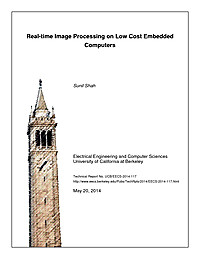
Real-time Image Processing on Low Cost Embedded Computers
In 2012 a federal mandate was imposed that required the FAA to integrate unmanned aerial systems (UAS) into the national airspace (NAS) by 2015 for civilian and commercial use. A significant driver for the increasing popularity of these systems is the rise in open hardware and open software solutions which allow hobbyists to build small UAS at low cost and without specialist equipment. This paper describes our work building, evaluating and improving performance of a vision-based system running on an embedded computer onboard such a small UAS. This system utilises open source software and open hardware to automatically land a multi-rotor UAS with high accuracy. Using parallel computing techniques, our final implementation runs at the maximum possible rate of 30 frames per second. This demonstrates a valid approach for implementing other real-time vision based systems onboard UAS using low power, small and economical embedded computers.

Guide to designing a device incorporating MEMS-based pico projection
Over the last few years, millions of products incorporating pico projection have shipped, and developers are innovating new applications for this rapidly growing display category. Ideal applications for pico projection include near eye display, interactive digital signage, head mounted display, ultra short throw (UST) TV, standalone portable projectors and embedded projection in smartphones, tablets and laptops. New uses continue to emerge; for example, you might be able imagine a design for a thermostat using a display powered by gesture recognition or interactive touch.

Getting Started with C Programming for the ATMEL AVR Microcontrollers
This tutorial provides information on the tool and the basic steps for programming the Atmel AVR microcontrollers using C. It is aimed at people who are new to this family of microcontrollers. The Atmel STK500 development board and the ATmega16 chip are used in this tutorial; however, it is easy to adopt the information given here for other AVR chips.
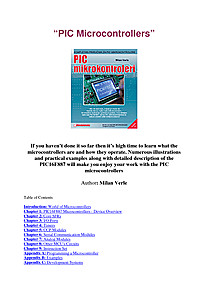
PIC Microcontrollers - Programming in C
If you haven’t done it so far then it’s high time to learn what the microcontrollers are and how they operate. Numerous illustrations and practical examples along with detailed description of the PIC16F887 will make you enjoy your work with the PIC microcontrollers

Microcontroller Programming and Interfacing
Chapter 7 of the book: Introduction to Mechatronics and Measurement Systems

Introduction to Microcontrollers
This text has been developed for the introductory courses on microcontrollers taught by the Institute of Computer Engineering at the Vienna University of Technology. It introduces undergraduate students to the field of microcontrollers – what they are, how they work, how they interface with their I/O components, and what considerations the programmer has to observe in hardware-based and embedded programming. This text is not intended to teach one particular controller architecture in depth, but should rather give an impression of the many possible architectures and solutions one can come across in today’s microcontrollers. We concentrate, however, on small 8-bit controllers and their most basic features, since they already offer enough variety to achieve our goals.

Real-Time Operating Systems and Programming Languages for Embedded Systems
Section 1 describes the main characteristics that a real-time operating system should have.
Section 2 discusses the scope of some of the more well known RTOSs.
Section 3 introduces the languages used for real-time programming and compares the main characteristics.
Section 4 presents and compares different alternatives for the implementation of real-time Java.

Software Development for Parallel and Multi-Core Processing
The embedded software industry wants microprocessors with increased computing functionality that maintains or reduces space, weight, and power (SWaP). Single core processors were the key embedded industry solution between 1980 and 2000 when large performance increases were being achieved on a yearly basis and were fulfilling the prophecy of Moore's Law. Moore's Law states that "the number of transistors that can be placed inexpensively on an integrated circuit doubles approximately every two years." With the increased transistors, came microprocessors with greater computing throughput while space, weight and power were decreasing. However, this 'free lunch' did not last forever. The additional power required for greater performance improvements became too great starting in 2000. Hence, single core microprocessors are no longer an optimal solution.
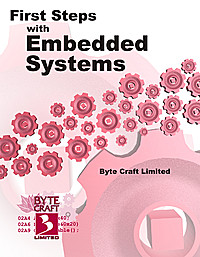
First Steps with Embedded Systems
This book is intended to fill the need for an intermediate level overview of programming microcontrollers using the C programming language. It is aimed specifically at two groups of readers who have different, yet overlapping needs. The first group are familiar with C but require an examination of the general nature of microcontrollers: what they are, how they behave and how best to use the C language to program them. The second group are familiar with microcontrollers but are new to the C programming language and wish to use C for microcontroller development projects. First Steps with Embedded Systems will be useful both as an introduction to microcontroller programming for intermediate level post-secondary programs and as a guide for developers coping with the growth and change of the microcontroller industry.

Creating a State-of-the Art, Cost Effective Energy Harvesting Bluetooth® Low Energy Switch
As IoT rapidly grows into new markets such as MHealth, Agriculture 4.0, and building automation, new questions are being raised about the energy required to support its growth. Within the industry, we see a broad spectrum of power requirements.

Getting Started with C Programming for the ATMEL AVR Microcontrollers
This tutorial provides information on the tool and the basic steps for programming the Atmel AVR microcontrollers using C. It is aimed at people who are new to this family of microcontrollers. The Atmel STK500 development board and the ATmega16 chip are used in this tutorial; however, it is easy to adopt the information given here for other AVR chips.

Design and Implementation of the lwIP Stack
LwIP is an implementation of the TCP/IP protocol stack. The focus of the lwIP stack is to reduce memory usage and code size, making lwIP suitable for use in small clients with very limited resources such as embedded systems. In order to reduce processing and memory demands, lwIP uses a tailor made API that does not require any data copying. This report describes the design and implementation of lwIP. The algorithms and data struc- tures used both in the protocol implementations and in the sub systems such as the memory and bu®er management systems are described. Also included in this report is a reference manual for the lwIP API and some code examples of using lwIP.
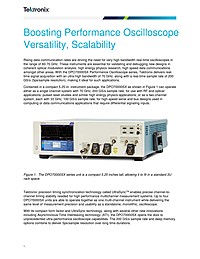
Boosting Performance Oscilloscope Versatility, Scalability Whitepaper
Rising data communication rates are driving the need for very high-bandwidth real-time oscilloscopes in the range of 60-70 GHz. These instruments are essential for validating and debugging new designs in coherent optical modulation analysis, high energy physics research, high speed data communications and other areas. With the DPO70000SX Performance Oscilloscope series, Tektronix delivers real-time signal acquisition with an ultra-high bandwidth of 70 GHz, along with a real-time sample rate of 200 GS/s (5ps/sample resolution), making it ideal for such applications.
Transforming 64-Bit Windows to Deliver Software-Only Real-Time Performance
Next-generation industrial, vision, medical and other systems seek to combine highend graphics and rich user interfaces with hard real-time performance, prioritization and precision.Today’s industrial PCs running 64-bit Windows, complemented by a separate scheduler on multicore multiprocessors, can deliver that precise real-time performance on software-defined peripherals.
Interface Protection for HDMI
The High-Definition Multimedia Interface (HDMI) combines a high-speed unidirectional TMDS data link with low speed, bidirectional control and status links (DDC and CEC) and configuration protocols in a single user-friendly highperformance connector.

Consistent Overhead Byte Stuffing
Byte stuffing is a process that transforms a sequence of data bytes that may contain ‘illegal’ or ‘reserved’ values into a potentially longer sequence that contains no occurrences of those values. The extra length is referred to in this paper as the overhead of the algorithm. To date, byte stuffing algorithms, such as those used by SLIP [RFC1055], PPP [RFC1662] and AX.25 [ARRL84], have been designed to incur low average overhead but have made little effort to minimize worst case overhead. Some increasingly popular network devices, however, care more about the worst case. For example, the transmission time for ISM-band packet radio transmitters is strictly limited by FCC regulation. To adhere to this regulation, the practice is to set the maximum packet size artificially low so that no packet, even after worst case overhead, can exceed the transmission time limit. This paper presents a new byte stuffing algorithm, called Consistent Overhead Byte Stuffing (COBS), that tightly bounds the worst case overhead. It guarantees in the worst case to add no more than one byte in 254 to any packet. Furthermore, the algorithm is computationally cheap, and its average overhead is very competitive with that of existing algorithms.
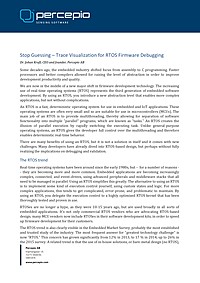
Stop Guessing – Trace Visualization for RTOS Firmware Debugging
Some decades ago, the embedded industry shifted focus from assembly to C programming. Faster processors and better compilers allowed for raising the level of abstraction in order to improve development productivity and quality. We are now in the middle of a new major shift in firmware development technology. The increasing use of real-time operating systems (RTOS) represents the third generation of embedded software development. By using an RTOS, you introduce a new abstraction level that enables more complex applications, but not without complications.
Improving Battery Management System Performance and Cost with Altera FPGAs
The purpose of this white paper is to evaluate improvements to Battery Management System (BMS) performance and cost with Altera® FPGAs. In many high-voltage battery systems, including electric vehicles, grid attached storage and industrial applications, the battery is a significant portion of the system cost, and needs to be carefully managed by a BMS to maximize battery life and to optimize charging and discharging performance. This white paper presents the BMS functional requirements for these applications and outlines existing BMS architectures. Key BMS architectural challenges are discussed and opportunities for Altera devices are identified. For each of these opportunities, the performance and cost of the existing solution are compared with Altera FPGA solutions. Altera devices provide architectural flexibility, scalability, customization, performance improvements, and system cost savings in BMS applications.
Electrical Ground Rules Part 1
Best Practices for Grounding Your Electrical Equipment A look at circuit grounding and its importance to you, as well as the US AC power system and its use of earth ground (Part 1 of 3)



















